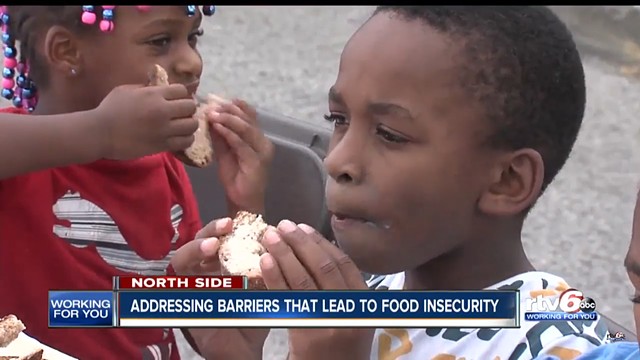2019: A Community Meal
At the Crossroads: A Community Meal engaged Meridian Kessler, Mapleton Fall Creek, Butler Tarkington, Crown Hill & Riverside in Phase 1 of a multi-year Social Practice project lead by artist, Seitu Jones. Providing a platform for our neighboring communities, this project invited 250 residents around a 400 foot-long table to dine together and discuss issues of food security and systemic racism. At the Crossroads also aims to highlight the ongoing efforts of Newfields' partners on the project to address the issue of food insecurity and the historically racist housing and environmental policies that contributed to the formation of food deserts and continue to impact our communities to this day.
Menu:
Country Loaves
provided by Amelia’s Bakery
served with honey butter
Fresh Leaves Salad
Prepared by Chef Corey McDaniel
Locally grown garden vegetables and toasted seeds served with coconut vinaigrette
Sweet Corn Soup
Prepared by Joshua Ratliff, Director of Culinary Arts, Newfields
Locally grown garden vegetables blended into a hearty soup and served with collard greens and toasted chili flakes
Dessert
provided by Second Helpings
Fresh produce provided by:
Flanner Farm
Butler University Center for Urban Ecology
Lawrence Community Garden
Growing Places Indy
LaShawnda Crowe Storm
redLINES, (2019)
quilted table runner
421' x 1'
Poets:
Januarie York, Dajanae Harges, and Synergy
Thank you to the following individuals and organizations for their generous support and participation:
Robert and Christine Baldwin, David Bryant, Butler Tarkington Neighborhood Association, Central Indiana Community Foundation, Corteva, David and Lisa Clarke, Judy Donner and John Mullen, Engaging Solutions, LLC, Jim Fuller, Groundwork Indy, Mark Grove, Matt Gutwein and Jane Henegar, Sarah Halter, HCO Architects, Indiana Medical History Museum, Greg and Pat Jacoby, Becky Kapsalis, pegg kennedy and Michael Kennedy, Kheprw Institute, Lilly Endowment Inc., Martin Luther King Community Center, Sabae Martin, Mo McReynolds, Jill Meisenheimer, Midtown Indianapolis, Inc., North United Methodist Church, Robert and Sharon Reed, Gary and Ann Reiter, Nancy R. Ross, Ann M. Stack, Bob and Ellen Whitt, Robin and Charlitta Winston, Dr. Robert Yee and Linda Yee
Photos by Samantha Veach, Eric Lubrick, and Matt Carlson courtesy of Newfields.
A ‘LIVING ARTWORK’ WILL SHUT DOWN 39TH STREET ON SATURDAY. THE ARTIST’S GOAL? FOOD EQUITY.
Amanda Kingsbury | September 26, 2019, 07:47 pm
In 2014, artist Seitu Jones wanted to start a conversation with his neighbors in St. Paul, Minnesota, about food traditions, food access, and food justice. So he threw a dinner party of sorts. On a warm September afternoon, 2,000 people sat down to eat locally produced food at a half-mile-long table in the middle of Victoria Street in the Frogtown neighborhood, named back in the 1860s for its marshes and swamps.
“There are still a couple folks, that when I see them, they say, ‘Oh, you’re the guy who closed the street!” Jones said. “I never thought that would be a thing, but closing the street became a demonstration that people have the power, and ability, to even make a change like that.”
This Saturday in Indianapolis, 300 invited guests will join their neighbors at a table in the middle of 39th Street, between Meridian and Illinois, for a community meal hosted by Jones, in partnership with Newfields. Indianapolis artist LaShawnda Crowe Storm created the 421-foot quilted table runner, redLINES. It will also serve as the touchpoint for open conversations about food justice issues and redlining, a historical practice that denied services, such as real estate investments and loans, to certain populations.
Based on different factors, local neighborhoods would earn yellow, blue, green, or red designations on a map, and “the blacker, browner, or poorer the community, the redder the map,” Crowe Storm said. The 38th Street corridor was one such area.
“redLINES asks us to consider the historical harm,” Crowe Storm wrote in her artist’s statement. “What makes us angry or ‘see red’ about these histories, about these realities? How do we redraw the map for a more equitable and racially just future?”
The goal of At the Crossroads: A Community Meal is to show how local creatives, growers, neighborhoods, and institutions can work together to create food equity. About one-third of Indianapolis residents live in food deserts, areas that lack healthy food providers such as grocery stores and farmers’ markets. Without easy access to fresh, nutritious food, people are more susceptible to chronic, debilitating diseases such as Type 2 diabetes and hypertension.
In St. Paul, Jones had teamed up with Public Art Saint Paul – along with farmers, artists, chefs, residents, and volunteers - to launch crEATe: A Community Meal. Before that, though, he spent two years on a “listening tour,” organizing discussions and knocking on people’s doors.
He studied urban food systems. Jones, who has a graduate degree in environmental history from the University of Minnesota, has also spent 18 months as a Senior Fellow in Agricultural Systems in the College of Food, Agriculture and Natural Science Resources at the University of Minnesota.
In the fall of 2017, Bryn Jackson, Assistant Curator of Audience Engagement and Performance at Newfields, met Jones while volunteering at the HeARTside Community Dinner during ArtPrize, the international art competition and festival in Grand Rapids, Michigan. Jones’ project, a public art installation designed to spark conversation about food access, won the $200,000 juried grand prize.
Jackson wanted to bring the concept to Indianapolis. But usually when a museum commissions an artist to do a piece of work, an object or performance results. Crossroads is a “living work of art,” a socially and politically engaged piece that wouldn’t be complete without robust community participation and planning, Jackson said. But it’s also a multi-year project with a goal of empowering and providing a platform for Central Indiana residents, improving their access to fresh, affordable food, and creating equitable food policies.
“To look at what communities are facing, and not say we are coming to fix the problem – but that we want to listen, to help, to be an ally, is exciting,” said Tariq Robinson, Manager of Outreach and Community Programs at Newfields. “And not just exciting – it’s the right thing to do.”
Jones has visited Indianapolis four times to get a sense of the city, meet community residents and learn about their experiences. Most recently, he traveled with a folded bike, and then rode along the Monon and White River trails to explore local neighborhoods.
“Part of it is about really listening, deep listening,” Jones said. “And being open to being challenged, to being critiqued, and really being in sincere conversation with someone.”
In St. Paul, Jones, who is a Master Gardener, was one of the guiding forces behind the five-acre organic Frogtown Park and Farm. He introduced his neighbors to area growers and chefs to help dispel the myths and distrust they had about food production.
Over his nearly five-decade career, Jones has created about 30 large-scale public installations, and his work often brings together art, water, the environment, and agriculture. All were interests he had as a child, when an aunt nicknamed him “little George Washington Carver” because of his intense curiosity about plants. Jones, who was born in St. Paul in 1951, grew up helping his grandmother in her garden, and spent a lot of time in fishing boats with his father, grandfather, and uncles.
But he also remembers the shift in the 1960s and ‘70s toward processed foods, and eating TV dinners on “special occasions” and drinking Tang.
“My mother and grandmother and my aunts, they used to make fresh-squeezed orange juice and I put that down for Tang?” Jones said, laughing.
“Now there’s this desire to think about the food that our grandparents made and ate, and the fact that all of us have these dishes that were shaped by our family and culture and the land - and how adamant we were to ignore and throw all of that way,” he said. “But only to find out that it’s been killing us.”
At Saturday’s dinner on 39th Street, the 300 guests will sit down to a simple, nutritious and freshly made meal: bread from Amelia’s Bakery, a salad with locally grown garden vegetables by Indianapolis Chef Corey McDaniel, a sweet corn soup made by Joshua Ratliff, Director of Culinary Arts at Newfields, and key lime pie from Second Helpings. Local poet Januarie York has written the grace, which will be read by her student, Dajanae Harges, and poet Synergy has written and will deliver the benediction.
And while the first 'Crossroads' is underway, Jackson is already thinking ahead to Year 2, when he hopes to involve even more neighborhoods and inspire other institutions to work with local communities to bring about real social change.
“I’m hoping this can be a roadmap, or even just an example of how this can be done,” Jackson said. “There are so many ways to successfully rebuild relationships with communities that have been left behind by institutions, and they all begin with listening.”










